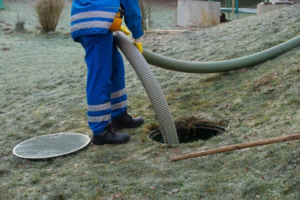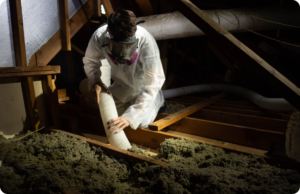A septic tank houses your home’s waste. Solids (oils and grease) float to the top, where microorganisms decompose. Water carries away the sludge and solids and flows through the outlet pipe into the absorption area—a drain or leach field.
A septic system can reduce pollution and help nearby plants and wildlife. Click https://www.septictankarmadale.com.au/ to learn more.

Septic tanks are underground storage containers for sewage waste for homes without city sewer systems. They vary in size and composition, but the basic function is the same: to hold sewage waste until a soil absorption field can treat it.
When a homeowner purchases a septic system, they are investing in a way to dispose of their waste more environmentally responsible and less expensively than traditional methods. This is especially important for those who live in a rural area where the costs of connecting to public sewers can be prohibitive.
The septic tank is buried in the ground, usually in the backyard of the home, where it links to the drain field (also known as a leach field) through a pipe. The wastewater travels from the septic tank to the drain field, where the waste is absorbed by the surrounding soil. During the treatment process, microbes on or near the soil break down the organic materials in the wastewater before it is discharged into the environment.
As a homeowner, there are several things that you can do to help keep your septic tank working effectively. One important thing is to keep it pumped regularly. It is recommended that a septic tank be pumped when the sludge layer reaches one-third full. This will extend the life of your septic system and reduce the risk of leakage from the tank.
Another thing you can do to prolong the life of your septic tank is to be careful with what you put into it. Doing excessive laundry loads and/or putting too much water down the toilet can overload your septic system and cause it to fail prematurely.
Also, make sure to install risers on your septic tank. Having these will make accessing the tank easier and safer for pumping and inspections. Do not park cars or trucks over your tank or drainfield, as the weight can damage it. Finally, be sure to plant trees or other vegetation at least 30 feet away from your septic tank and drainfield. Tree roots can clog pipes and overflow your drainfield.
Inspections
Many home inspectors include a simple dye test in their standard inspection of a septic system. This can indicate whether or not the septic tank is full, but it tells nothing about the condition of the absorption field or whether it is capable of handling a new homeowner’s wastewater usage. If you’re buying a home with a septic tank, ask for a more thorough septic inspection.
Local regulations often dictate the location of a septic tank and how far it’s allowed to drain into the absorption field. Your home’s deed or property survey may contain a sketch of the tank and its location. Your septic system permit should also provide this information, as well as a history of pumping and maintenance records.
Septic tanks work by allowing solid waste to settle at the bottom and liquids to rise to the top, where bacteria break it down further. A septic tank that hasn’t been pumped in some time will typically have a thick layer of sludge at the bottom, indicating it needs to be pumped. The liquid at the top is known as effluent. It travels from the septic tank through pipes to the leaching field, where bacteria further purify it in the soil.
Regular inspections can identify minor problems before they cause serious septic system failure and costly repairs. For example, a septic tank that is overloaded with sludge and scum can fail, leading to sewage backups, foul odors and contaminated groundwater. In addition to regular tank cleaning and pumping, you can help prevent septic system failure by limiting water usage, planting grass or shallow-rooted plants over the absorption field and installing appliances that use less water and are low-energy.
Drain Field Failure
The drain field, also known as the leach field, is an integral part of your septic system. It’s a network of pipes and trenches that receive pre-treated sewage effluent from your septic tank, distributing it to soil for even more filtration and purification. The drain field is also responsible for preventing dangerous sewage from backing up into your home.
A failing drain field can lead to a failed septic system, polluting groundwater and local drinking water sources with disease-causing bacteria. The cause of a failing leach field can be anything from putting too much water into your septic system at one time (dishwasher, washing machine, toilet) to not having your septic tank pumped on a regular basis. Other causes include adding a pool, hot tub, garbage disposal or laundry room, driving vehicles over the area, planting shrubs and trees too close to the drain field and using chemical products that can clog soil pores.
Failing septic systems can also be caused by improper tank installation, improper system sizing, soil compaction, and improper maintenance of the leach field area. Improper maintenance of the drain field area includes soil erosion, root intrusion, and excessive sand or gravel placed in the drain field area. A septic service professional will advise you on the proper distance to plant trees and shrubs in the area surrounding your septic system, depending on the type of soil your home is on.
Another sign of a failing drain field is if you have an earthy, musty odor. This is because sewage has seeped from the underground pipes and into the surrounding soil. This odor can be difficult to get rid of.
Having a well-functioning septic system is essential for the health of your family and the environment. You can avoid costly repairs and drain field failure by taking care of your septic tank and keeping up with routine inspections and pumping. Avoid putting any non-septic safe products down your drains (grease, paint, medications, cigarette butts) and by limiting the number of people using the septic system at once. Having a septic system that’s properly maintained can protect the health and safety of your family for years to come.
Installation
A septic tank is a large, underground container that’s made of concrete or fiberglass. It’s designed to hold wastewater long enough to allow solids to settle down into the bottom forming sludge, and oils and grease float to the top forming scum. The liquid waste then exits the tank through pipes into the drain field area.
A professional installer has the knowledge, expertise and equipment to ensure a safe, high-quality septic system is installed correctly the first time around. Professional installation also helps ensure compliance with local regulations including permits, inspections and testing. It saves homeowners money in the long run as professional installation can help prevent costly repairs and replacement of a faulty septic tank or absorption field.
If the septic tank is not properly sized to fit the home, it may become overloaded with sludge and scum. This can cause the septic tank to overflow and spill sewage on the ground surface. This exposes people and animals to disease-causing organisms and can lead to expensive repairs. A professional septic tank installer will make sure the right-sized septic tank and leach field is installed for the size of the home.
The septic tank and drain field are connected by pipes that carry the pre-treated wastewater to the soil. The permeable soil in the drain field naturally treats the sewage so that it doesn’t pollute nearby waterways or surface. In addition, the septic system relies on an ecosystem of bacteria in the surrounding soil to treat the sewage. This is why it’s important not to introduce any bacteria-killing chemicals or additives into the septic system.
During installation, the installer will dig a trench to accommodate the septic tank and piping. The trench is then backfilled carefully to avoid damage to the septic tank or piping. The installer will also install the septic tank and the piping from the septic tank to the drain field. This can involve installing a baffle wall to separate the chambers inside the tank, and the outlet pipe is equipped with a filter to remove any sludge or scum from leaving the septic system.



